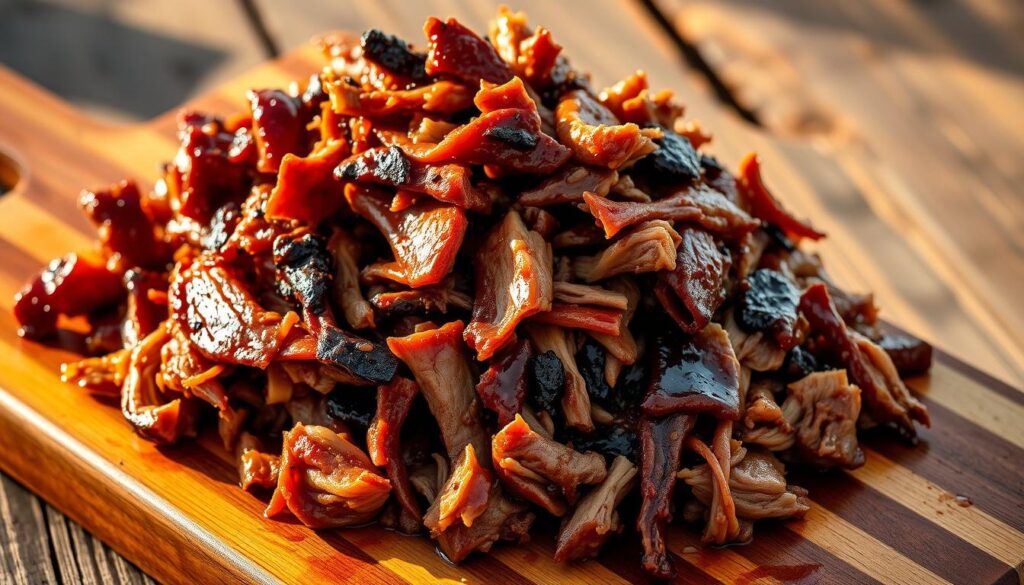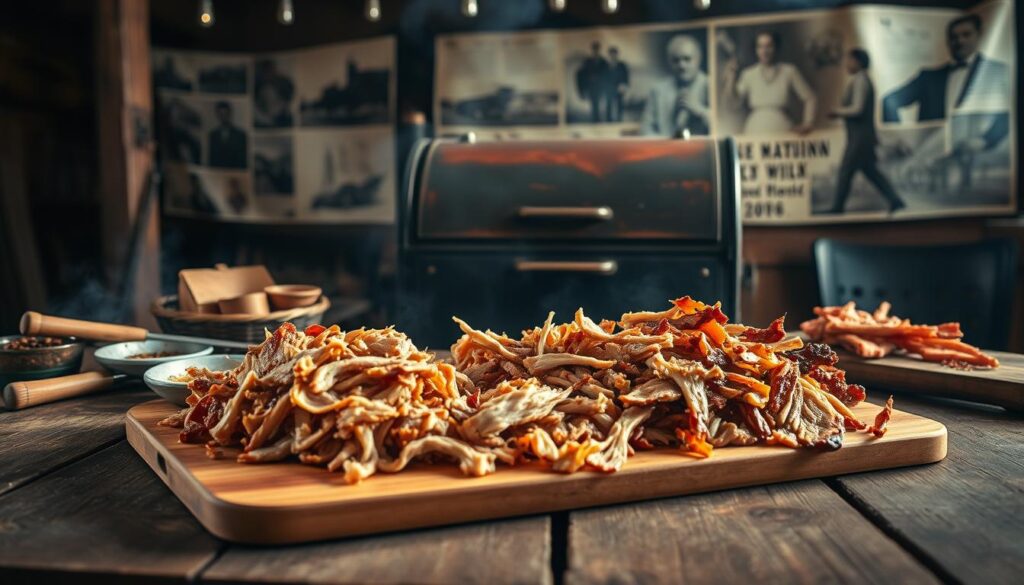Summer gatherings around the grill are truly special. I cherish memories of family laughter and the smell of barbecue pulled pork in our backyard. It’s a joy to pull apart that tender meat and put it on a bun.
If you want to make those moments again, you’re in the right spot. I’ll share how to make that delicious, tender pulled pork everyone loves. Let’s get started on our grilling adventure.
Key Takeaways
- Pork shoulder, or Boston butt, is ideal for its marbled texture that ensures tenderness.
- A flavorful BBQ dry rub enhances the pork with spices like chili powder and smoked paprika.
- Multiple cooking methods are available, including stovetop, oven, slow cooker, and Instant Pot.
- Cook the pork until it reaches an internal temperature of 205°F for perfect tenderness.
- Barbecue pulled pork is versatile, served as sandwiches, wraps, or even salads.
- This recipe yields sizable portions, great for feeding a crowd at family gatherings.
Introduction to Barbecue Pulled Pork
Barbecue pulled pork is loved for its rich flavors and versatility. It’s perfect for gatherings, bringing people together over delicious food. The tender meat is a hit in many recipes, pleasing different tastes.
Choosing a good cut, like a bone-in pork butt, is key. It adds flavor and gives plenty of meat for everyone. I use Steven’s Project Smoke Carolina Pit Powder for extra taste. Cooking it at 275 degrees until tender makes it perfect for sandwiches, nachos, or ramen.
In this guide, I’ll share how to make amazing barbecue pulled pork. You’ll learn the techniques to impress your guests. Get ready to explore every detail of this tasty dish.

The History and Origins of Pulled Pork
Pulled pork has deep roots in American barbecue, especially in the South. Early settlers found pigs thrived in the warm climate, making pork a key meat. The 16th century saw Spanish settlers cook pork over low flames, a method they learned from indigenous peoples.
This method made the meat tender and flavorful, becoming a favorite dish. Over time, pulled pork became a key part of regional cultures. People used less desirable cuts of meat, turning them into a sought-after barbecue dish through slow cooking.
This slow cooking, which heats the meat to 195 to 205 °F (91 to 96 °C), makes it easy to shred and adds flavor. Traditional methods include a dry rub and sometimes brining to add moisture and depth.

Regional pulled pork dishes emerged, each with its own flavors and cooking styles. In North Carolina, vinegar-based sauce is key, while Tennessee uses sweet and spicy flavors. Pulled pork’s influence has spread, inspiring dishes like Kalua Pork in Polynesia.
The term “pork butt” comes from the shoulder cut, named after the barrels used for transport. This shows the dish’s rich history and evolution. From backyard cookouts to global menus, pulled pork’s appeal endures worldwide.
Why Choose Pork Shoulder for Pulled Pork?
Pork shoulder is a top pick for pulled pork because of its special features. It’s also known as Boston butt. It has a lot of fat marbling and connective tissue.
When cooked, the fat melts and the collagen breaks down. This makes the meat tender and full of flavor, perfect for barbecue.
Choosing pork shoulder also saves money. It’s cheaper than other cuts, making it great for big gatherings. It weighs 12 to 18 pounds, offering plenty of meat for everyone.
Its texture holds up well during cooking. This means it breaks down perfectly into pulled strands.
Preparing the meat is key. Keeping the fat cap on helps keep it moist. A good seasoning rub adds flavor, and injecting it with a mix of pork stock, salt, and sugar boosts taste and moisture.
In short, pork shoulder is a fantastic choice for pulled pork. It’s perfect for feeding a crowd or a family meal. Its rich flavor, juiciness, and tenderness make barbecue even better.
The Essential Ingredients for Perfect Barbecue Pulled Pork
To make the best barbecue pulled pork, start with the right ingredients. I always choose a 4 lb. boneless pork butt, also known as a pork shoulder. This cut has the perfect mix of fat and connective tissue. It makes the pork juicy and tender.
The barbecue dry rub is key to adding flavor. I mix 3 tablespoons of dark brown sugar for sweetness, 1 tablespoon of kosher salt, and spices like smoked paprika and garlic powder. Ground cumin, onion powder, and black pepper add depth and rich flavor.
Using cooking liquids also boosts moisture and taste. A 12 oz. can of lager beer tenderizes the meat and adds complexity to the flavor. Adding Worcestershire sauce and apple cider vinegar balances and highlights the flavors during cooking.
Lastly, making your own barbecue sauce is a must. Mix 1½ cups of ketchup, ½ cup of Dijon mustard, and ⅓ cup of apple cider vinegar for a tangy, sweet sauce. Brown sugar, liquid smoke, and orange zest can elevate your sauce, making it a perfect match for the pulled pork.
How to Prepare Your Pork Shoulder
Getting your pork shoulder ready is key for great barbecue pulled pork. You need to trim off excess fat and add a dry rub for flavor. Here’s how to do both steps right.
Trimming and Scoring the Meat
First, trim the pork shoulder. Place it on a cutting board, fat side down. Look for thick fat areas, like the fat cap on top. You want to keep about 1/4 inch of fat for flavor and tenderness.
Then, score the meat. Use a sharp knife to make shallow cuts in a crosshatch pattern on the fat cap. This lets the rub get into the meat better. Scoring also helps with even cooking and flavor.
Applying the Dry Rub
After trimming and scoring, it’s time for the dry rub. I mix bold flavors for a tasty dish. Here’s a good blend:
- 3 tablespoons sea salt
- 2 tablespoons black pepper
- 2 tablespoons garlic granules
- 2 tablespoons onion granules
- 2 tablespoons paprika
- 2 tablespoons cumin
Mix these spices well and coat the pork shoulder evenly. Make sure to cover every part. Let it sit for at least 30 minutes to soak up the flavors.
In short, to prepare pork shoulder, trim fat well and apply the dry rub carefully. These steps will help you make delicious barbecue pulled pork.
Understanding Different Cooking Methods
Choosing how to cook pulled pork affects its texture and taste. I’ve tried different methods, each with its own benefits. Knowing these can help you pick the best one for your schedule and taste.
Slow Cooking in a Crockpot
Crockpot pulled pork is easy and flavorful. I use a Boston butt roast seasoned with bay leaves and garlic. It cooks low and slow for 8 to 10 hours, until it’s tender.
After cooking, let the meat rest for 30 minutes. This helps it soak up all the juices.
Smoking on the Grill
Smoking pork adds a deep, smoky taste. I keep the grill at 225°F for even cooking. Wrapping the meat in foil helps it cook faster and stay juicy.
It’s important to check the meat’s internal temperature with a thermometer. This ensures it reaches 195°F. Then, I grill it for 15 minutes on each side to get a nice char.
Using the Instant Pot for Quick Pulled Pork
For quick pulled pork, the Instant Pot is a lifesaver. It cooks in about 60 to 90 minutes, keeping the meat tender and flavorful. This is perfect for busy days or unexpected guests.
The Cooking Process: Step by Step
Cooking pulled pork is an art that needs patience and precision. This guide will help you cook perfect, tender, and flavorful barbecue pork. Start with a 4-pound pork shoulder, which is ideal for this dish. Trim any excess fat and cut the pork into four pieces for even cooking.
Next, make your spice rub by mixing brown sugar, paprika, garlic powder, onion powder, mustard powder, cumin, salt, and black pepper. Rub this mixture all over the pork to enhance the flavor. If you’re adventurous, sear the pork in hot oil to lock in the flavors.
There are several ways to cook pulled pork. For a slow cooker, cook on low for 10 hours with beer, apple cider, or apple juice. In the oven, preheat to 300°F (150°C) and cook in a Dutch oven with cola for three hours, then another hour or two uncovered.
An Instant Pot is great for those in a hurry. Cook on manual/high pressure for 70 minutes, then let the pressure release naturally for 15 minutes. Use a probe thermometer to check the internal temperature of 190°F.
Let the pork rest for at least 30 minutes, covered with foil, before shredding. This step makes the pork tender. Serve the pulled pork in sliders with coleslaw or as part of a Southern BBQ dinner with mac and cheese, cornbread, steamed corn, and green beans.
| Cooking Method | Time | Ingredients |
|---|---|---|
| Slow Cooker | 10 hours on low | Beer, apple cider, or apple juice |
| Oven | 3-5 hours | 12 ounces of cola |
| Instant Pot | 70 minutes | None (add spices to the pork) |
By following these steps, you’ll get delicious pulled pork every time. Whether you use a slow cooker, oven, or Instant Pot, each method has its own charm.
How Long to Cook for Tenderness
Cooking pulled pork to the perfect tenderness needs careful attention to time and temperature. The total cooking time can be around 5 hours and 15 minutes. This depends on the method and the size of the cut.
First, cook the pork with the lid on for 4 hours. This step allows the flavors to meld and the meat to absorb moisture.
After the first 4 hours, remove the lid for an extra hour. This helps create a delicious bark while keeping the meat tender. Different cuts need different cooking times and temperatures.
For a pork tenderloin, cook on high for 4 to 5 hours or low for 6 to 7 hours. A pork loin might need a higher setting for 5 to 6 hours or low for 7 to 8 hours. This ensures a melt-in-your-mouth texture.
If the pork doesn’t shred easily, add 30 minutes intervals until it’s tender. The tender pulled pork should fall apart when pierced with a fork. Patience is key to achieving that richly flavored and tender result everyone loves.
Serving Suggestions for Barbecue Pulled Pork
Serving pulled pork is a great way to make a meal everyone will enjoy. This tender meat is perfect on a toasted bun, making classic pulled pork sandwiches. Pairing it with different side dishes can make the meal even better.
Classic Pulled Pork Sandwiches
One favorite way to enjoy pulled pork is in sandwiches. I serve it on soft, toasted buns to let the smoky flavor shine. Adding coleslaw adds texture and a cool contrast. You can also try different sauces like barbecue or sriracha for a kick.
Serving with Side Dishes
There are many great side dishes for pulled pork. Here are some top picks:
- Coleslaw: A creamy dressing balances the richness of pulled pork.
- Baked Beans: With bacon and brown sugar, these beans are a classic choice.
- French Fries: Crispy fries seasoned just right complement BBQ flavors.
- Corn Muffins: These quick breads are great for soaking up BBQ sauce.
- Potato Salad: A creamy, flavorful version rounds out the meal.
- Mac and Cheese: This comforting dish is perfect for BBQ spreads.
- Pasta Salad: A light, refreshing choice for summer gatherings.
- Potato Wedges: Seasoned to perfection, these are a tasty alternative to fries.
- Creamy Squash Casserole: A hearty dish that adds variety to the feast.
- Cucumber Salad: A fresh, tangy option keeps it light and vibrant.
- Asian-Inspired Coleslaw: With rice vinegar, soy sauce, and ginger, it’s a fantastic twist.
- Green Beans: Dressed with a tangy mustardy sauce, they add a flavorful crunch.
Tips for Storing and Reheating Leftovers
Properly storing pulled pork lets you enjoy its flavors for a long time. After cooking, refrigerate or freeze leftovers within 2 hours to avoid food poisoning. Leftover pulled pork stays good for 3-4 days in the fridge. For longer storage, use airtight containers or vacuum-sealed bags for up to 6 months in the freezer.
Reheating leftovers safely is key. Make sure to heat them to 165°F (74°C) to kill bacteria. I suggest using the oven, grill, or microwave for reheating. To keep the meat moist, cover it with foil or a lid. Here’s how to reheat pulled pork best:
- Let the pulled pork sit at room temperature for 15 minutes.
- Preheat the oven to 350°F.
- Add 1 tablespoon of water or broth to the meat.
- Wrap the dish in foil and reheat for 18 minutes.
Don’t reheat pulled pork more than once. This can lead to bacterial growth and lower meat quality. By following these tips, you ensure every bite is delicious and safe.
Why Barbecue Pulled Pork is a Crowd-Pleaser
Barbecue pulled pork is a favorite at many gatherings. Its comforting taste and easy sharing make it perfect for any event. At family barbecues, it’s always a hit, with everyone eager to try it.
A 5-pound raw pork shoulder cooks down to about 3 pounds, enough for 6 to 8 people. It’s great because you can serve it in many ways. Try it on soft rolls, over nachos, or in tortillas. It’s also good in salads, so everyone can make their own.
The popularity of pulled pork is growing, with a 35% increase in US barbecue dishes in UK restaurants. Places like Pitt Cue Co and Grillstock have made it a must-try. This shows how much people love it.
Pulled pork is also a staple in many family recipes. It’s perfect for gatherings because you can always have extra. The smoky taste and tender meat, with special seasonings and sauces, make it a hit with everyone.
Conclusion
As I finish this barbecue summary, I think about the joy of cooking pulled pork. It’s all about the right pork, seasonings, and cooking ways. I’ve made tender, tasty meat that everyone loves.
My 2.5kg pork butt was cooked at 145°C for 5.5 hours. It got a great bark and a delicious smoke ring. Everyone enjoyed it a lot.
It’s key to cook to 74°C and let it rest for 5 hours. This made the meat even softer. I got 2 kilos of tasty shredded pork, great for freezing.
Serving it in pulled pork sandwiches with grilled zucchini made a wonderful meal. It was a special time with family and friends.
I suggest trying new things when cooking pork. Try slow cooking or different rubs to find your favorite flavors. Sharing this dish with loved ones is truly special. I hope you start your own pulled pork journey soon.
FAQ
What is the best cut of pork for making pulled pork?
Pork shoulder, also known as Boston butt, is the top choice for pulled pork. It has lots of marbling and connective tissue. This makes the meat tender and flavorful, perfect for pulling apart.
How long should I cook pulled pork for optimal tenderness?
Cooking time varies based on the pork shoulder’s weight and the method used. It’s best to cook it low and slow for hours. This can be in a crockpot, on a grill, or in an Instant Pot. This way, it becomes incredibly tender.
Can I use different types of barbecue sauces for pulled pork?
Yes! You can try out many barbecue sauces with pulled pork. From tangy vinegar-based to sweet tomato-based, each adds a unique flavor. It’s a great way to find your favorite taste.
What sides pair well with barbecue pulled pork?
Classic sides include coleslaw, mac and cheese, baked beans, and corn on the cob. These sides complement the rich flavors of pulled pork. They make a complete meal.
How can I store leftovers from my barbecue pulled pork?
Cool the leftover pulled pork completely before storing. Put it in airtight containers. It keeps in the fridge for 3-4 days or longer in the freezer. Reheat it gently in the oven or on the stovetop to keep it moist and flavorful.
What are some creative ways to serve pulled pork?
You can serve pulled pork in tacos, on nachos, or on baked potatoes. It’s also great in pasta dishes for a flavor twist.
Is it possible to make pulled pork without a grill?
Yes! You can make delicious pulled pork in a crockpot or Instant Pot without a grill. Both methods result in tender pork that’s perfect with your favorite sides.
How do I know when my pulled pork is done cooking?
Use a meat thermometer to check if the pork is done. It should reach 195°F to 205°F for tenderness. When it hits this temperature, the meat will shred easily.
SEE MORE : Cinnamon Roll Casserole with Cream Cheese Glaze
